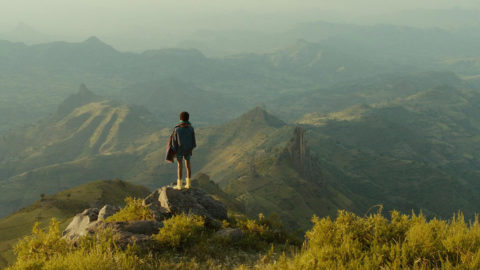Film of the Week: Rabin, The Last Day
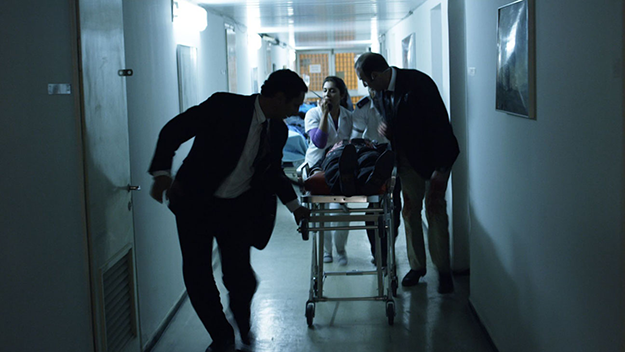
Director Amos Gitai gives himself just a few seconds’ worth of cameo in his Rabin, The Last Day. He’s seen as an officer present at a Tel Aviv police station on November 4, 1995, when a young man named Yigal Amir is brought in, having just fatally shot Israel’s Prime Minister Yitzhak Rabin. “Take that scumbag to interrogation,” says Gitai’s cop—and that’s essentially what his film does, performing an extended, cool-headedly prosecuted act of interrogation. But the object of inquiry is not so much Amir himself, more an ideological malaise within Israeli society that caused this tragic and historically ruinous event to happen.
While there is a streak of conspiracy theory to be found in the reconstruction of the events surrounding Rabin’s assassination, Gitai’s speculation comes across as sane and well-founded, rather than wild-eyed and sensational. You wouldn’t expect Gitai, who has long represented the sober political conscience of Israeli cinema, to make anything as hyperventilating as an Israeli JFK. As it happens, Rabin is closer to Costa-Gavras—there are thriller aspects, notably in Amit Poznansky’s tensely insistent score, and in the image of Amir loading his gun before holding it in a generic assassin’s pose.
But the film uses its dramatization in a detached, coolly forensic way. Written by Gitai and Marie-Jose Sanselme, with research credited to Rivka Markovitzky Gitai, the film is a fascinating history lesson—and a thinking lesson. Gitai’s reconstruction of certain events and discussions leaves salient gaps; while telling you all you need in order to grasp the drama’s background, the film also sends you running to look up more. In the Internet age, docudramas have become more than ever the thing that they can most usefully be: suggestions for further reading.
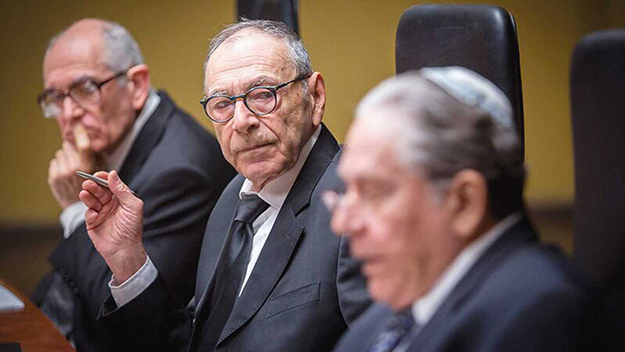
The film recounts events immediately before and after the shooting, which took place at a rally in what is now Rabin Square in Tel Aviv. The event was in support of Rabin’s government and of the Israel-Palestine peace process, centered around the Oslo Agreement, which involved Israel’s recognition of the PLO, the rights of the Palestinian people, and the closing down of Israeli settlements in occupied Gaza. Needless to say, this did not make Rabin popular with Israeli’s Zionist right wing. His colleague and successor Shimon Peres—then Foreign Minister, later Prime Minister and President—explains in a seven-minute interview at the start that Rabin found himself pilloried and threatened by the Israeli right. “Sedition was in the air,” Peres says. “Not organized sedition, but the atmosphere made it possible.” Without overstating its case, however, Gitai’s film makes you wonder whether, in fact, there was organized sedition, and whether Amir was its tool. Rabin’s death, and the subsequent coming to power of Benjamin Netanyahu’s right-wing Likud party, would decisively derail the peace process.
The film is a patchwork: archival footage variously showing Rabin speaking, or attempting to speak, against the background of a parliamentary shouting match; documentary footage of rallies and other crowd scenes, showing the polarity between supporters of the peace process and its opponents, some of whom angrily vow, “We’ll get rid of Rabin by blood and fire”; a poignant, sober interview with Rabin’s widow Leah; dramatic reconstruction of the shooting itself, the rush to get the wounded PM to hospital, and Amir’s arrest; and substantially, dramatic scenes depicting the hearings of the Shamgar Commission, and based on its transcripts.
The commission was tasked with investigating the conditions and the security lapses that allowed Amir to get close enough to kill Rabin. It’s the scenes at the hearings that most clearly define the particular tenor of the film. While the moments following the shooting are shot by DP Eric Gautier with breathless intensity—on the drive to hospital, the camera hunkers down in the back of Rabin’s car, his anxious bodyguard lying over his bleeding boss—by contrast, the hearing is treated with a quiet neutrality. It takes place in a large room, three elderly men presiding, with two younger lawyers, a woman and a man, in attendance; the room, austere and nondescript, is first shown in an extended scene, during which the camera slowly drifts from the conferring senior trio to a back area, an archive where evidence is gathered. The locale becomes a sort of theatrical stage—which is, after all, what courtrooms invariably become in cinema—on which a succession of actors enter to play their part, but always quietly as in a solemn chamber drama, rather than grandstanding to an audience. This huis clos allows us to be more dispassionate as we assess the evidence—or sometimes, tellingly, the dearth of it.
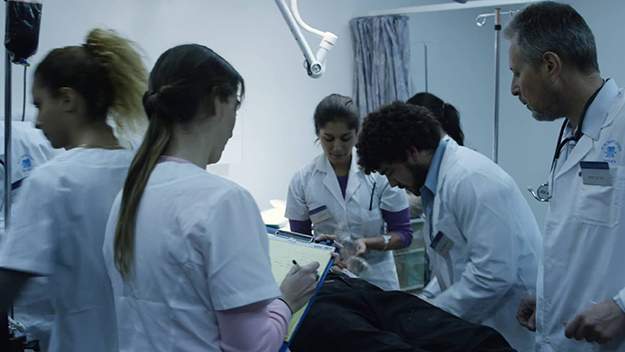
The film’s strangest scenes show backstage moments among Rabin’s adversaries on the ultra-Orthodox right. Perhaps the most shocking moment, affording some ghastly black comedy, comes when a psychologist, played by Dalia Shimko, delivers a highly dubious professional opinion of Rabin, diagnosing him (before she herself breaks down in tears) as “schizoid . . . suffering delusions without basis on objective reality.” It’s a description that, in the course of events, increasingly seems applicable to Rabin’s religious enemies, with their appeal to biblical absolutes rather than humane political realities.
These scenes show Rabin being made subject to a Pulsa Dinura—essentially, a religious malediction on enemies of Israel, apparently only declared once before since the Middle Ages, on Leon Trotsky. The Pulsa Dinura simply calls upon “the Angels of Destruction” and forecasts that the victim will die in a month. But does this mean leaving the subject’s fate in the hands of metaphysical forces—or does it effectively declare Rabin a sitting target for anyone fanatical enough to see themselves as an instrument of divine justice?
It may be that Yigal Amir unanimously appointed himself executioner. A 26-year-old student of law and computing at Tel Aviv’s Bar-Ilan University, and a member of the right-wing group Eyal, Amir displays breathtaking arrogance under interrogation, casually remarking: “I figured, if the opportunity comes up…” (He is played by Yogev Yefet not as a frenzied visionary, but as a disarmingly cool operator, contemptuously defying an authority he doesn’t regard as legitimate.) Another scene, however, shows Amir with his Biblical teacher, who draws his attention to a religious text he’s left for him to read: it involves the din rodef, a law that legitimizes certain killings as righteous. “You get my meaning,” says the teacher; on reading the text, Aviv closes his eyes and nods, as if he knows that he’s been entrusted with a mission.
There’s more: the mystery of the lax security at the rally, leaving Rabin so obviously exposed to attack. It emerges that anyone not authorized to be on the scene was made to leave. But Amir was not ejected. Does that mean that he had been given clearance to be present—and if so, why and by whom? This question would seem to take us into a bottomless abyss of Oliver Stone logic.
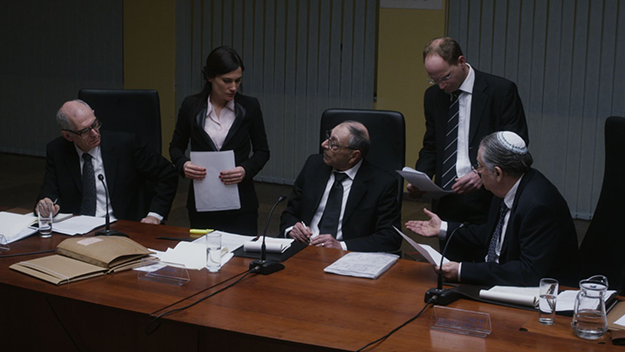
Here is where the film’s most tantalizing lacuna plays its part. A voluntary witness, a teacher in a girls’ school, comes to the commission to report one Avishai Raviv, a man who, her pupils reported, was going round stirring up hatred, preaching that Arabs should be killed, and that the government should be blown up. It’s not explained who Avishai Raviv is, or his connection with the drama—and the scene abruptly ends when we hear that all material concerning him is classified. He’s never mentioned again—but some brief Googling reveals that he had been a member of the Shin Bet security service, as well as a member of Eyal.
Gitai doesn’t give us enough information to jump to conclusions before we’ve delved further into the facts—that’s the whole point of his approach—but the film leaves us with several possibilities. Amir might have been a solo fanatic who simply saw his chance; he might have been prompted, or at the very least, given a tacit blessing by those who knew that he, like many of his peers, had access to weapons (in a sequence showing young Israeli settlers, baby-faced kids with a dress code half-hippie half-Hassidic, we see prayer books and Uzis side by side on the same table). But could it be that Amir had contacts in official security circles that got him clearance to be close to Rabin in the square?
In the end, the striking thing is the hearings’ conclusion, and the reminder that the commission has been authorized only to examine the strict circumstances surrounding the shooting. Earlier on, the commission heads listen to their younger colleagues as they outline ideological stresses in Israel: the beliefs of the far right, the way that aggressive settlement building violates international agreements and Palestinians’ rights (the latter passage is the only moment at which the film’s didactic function becomes awkwardly overt). But the presiding triumvirate argue that these issues are beyond the scope of the inquiry. It’s only at the very end that one of the three older men opines wearily that a future investigation needs to be carried out into the role of extremism in Israel, and the way that it has been able to override the processes of democracy. All one can say is that with its calm, dispassionate tone, Gitai’s film is certainly a start—one to consider when, in the film’s final shot, the commission member wearily leaves his building, and walks past a wall of political posters for Netanyahu’s party. It’s a reminder of the seemingly blocked future that actually came about, instead of the hopeful one that might have happened for Israel and Palestine.



